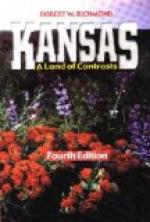cities, and the subtler nature of its influence seemed
to magnify its pervasive force.] None the less do the
people of the United States, compared with those of
any one European country, seem to me to have their
due share of variety and even of picturesqueness.
This latter quality is indeed denied to the United
States not only by European visitors, but also by many
Americans. This denial, however, rests on a limited
and traditional use of the word picturesque.
America has not the European picturesqueness of costume,
of relics of the past, of the constant presence of
the potential foeman at the gate. But apart altogether
from the almost theatrical romance of frontier life
and the now obsolescent conflict with the aborigines,
is there not some element of the picturesque in the
processes of readjustment by which the emigrants of
European stock have adapted themselves and are adapting
themselves to the conditions of the New World?
In some ways the nineteenth century is the most romantic
of all; and the United States embody and express it
as no other country. Is there not a picturesque
side to the triumph of civilisation over barbarism?
Is there nothing of the picturesque in the long thin
lines of gleaming steel, thrown across the countless
miles of desert sand and alkali plain, and in the mighty
mass of metal with its glare of cyclopean eye and
its banner of fire-illumined smoke, that bears the
conquerors of stubborn nature from side to side of
the great continent? Is there not an element of
the picturesque in the struggles of the Western farmer?
Can anything be finer in its way than a night view
of Pittsburg—that “Hell with its lid
off,” where the cold gleam of electricity vies
with the lurid glare of the furnaces and smelting
works? I say nothing of the Californian Missions;
of the sallow creoles of New Orleans with their gorgeous
processions of Mardi-Gras; or of the almost equally
fantastic fete of the Veiled Prophet of St. Louis;
or of the lumberers of Michigan; or of the Mexicans
of Arizona; or of the German beer-gardens of Chicago;
or of the swinging lanterns and banners of Chinatown
in San Francisco and Mott street in New York; or of
the Italians of Mulberry Bend in the latter city;
or of the alternating stretches on a long railway
journey of forest and prairie, yellow corn-fields and
sandy desert; or of many other classes and conditions
which are by no means void of material for the artist
in pen or brush. All these lend hues that are
anything but prosaic to my kaleidoscopic recollections
of the United States; but more than all these, the
characteristically picturesque feature of American
life, stands out the omnipresent negro. It was
a thrill to have one’s boots blackened by a
coloured “professor” in an alley-way of
Boston, and to hear his richly intoned “as shoh’s
you’re bawn.” It was a delight to
see the negro couples in the Public Garden, conducting
themselves and their courting, as Mr. Howells has well
remarked, with infinitely more restraint and refinement




